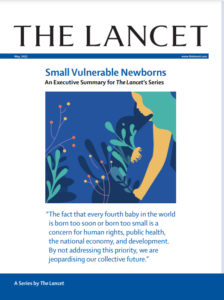
The foundations of human wellbeing are laid before birth. Unfortunately, many babies experience adversities during this intrauterine period. Consequently, they can be born preterm or suffer fetal growth restriction and be born small for gestational age (SGA). Both preterm birth and fetal growth restriction can result in low birthweight (LBW). Children who are born preterm, SGA, or with LBW have a markedly increased risk of stillbirth, neonatal death, and later childhood mortality. Additionally, these conditions are associated with multiple morbidities with short- and long-term adverse consequences, for newborns, their families, and society at-large, resulting in a major loss of human and economic capital. Prevention of preterm and SGA births is critical for global child health and for societal development. This Series presents a new conceptual framework that brings preterm birth, SGA, and LBW together under the term “small vulnerable newborns” (SVN) in order to contribute to healthier and thriving women, newborns, children, adults, and societies.
Series:
Small vulnerable newborns—big potential for impact
Biological and pathological mechanisms leading to the birth of a small vulnerable newborn